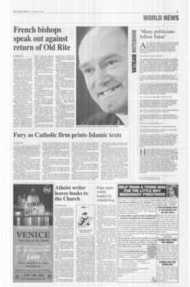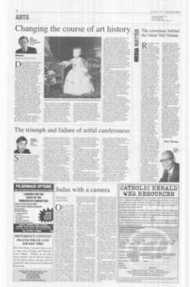Page 13, 27th October 2006
Page 13

Report an error
Noticed an error on this page?If you've noticed an error in this article please click here to report it.
Tags
Share
Related articles
The Spa Nisii Question Some Facts
Spain's Civil War Outbreak Celebrated
Palm Euston's Foreign Policy
First Glimpses Of The New Spain
77,000 Nationalists Killed In Spain
An uncivil war
Guerra: Living in the Shadows of the Spanish Civil War by Jason Webster, Doubleday £12.99
iiirason Webster's first two books on Spain, Duende and Andalus, were marked by guileless enthusiasm, telling lively tales of love and the Moorish influence on Spain, respectively. The third in the trilogy, Guerra, takes on an altogether darker, more sombre subject: the Spanish Civil War.
When stumbling across an unmarked grave in the Spanish countryside, Webster's curiosity is aroused. When he then witnesses a violent, bloody fight (cheered on by a baying mob) and espies a poster for the Falange (the Spanish fascist party and Franco's supporters during the war), he begins to reassess his evaluation of Spain and her people.
"Why was there so much reticence to discuss the Spanish Civil War and why is it only now that I notice this latent violence?" he asks.
From this unmarked grave begins Webster's broad analysis of the Spanish Civil War and the years that tore the country apart.
Rather than adopting a soberly historical and chronological approach, Webster highlights pivotal moments from the war and colourfully draws them in.
Thus the death of Lorca, ("his murder has become a lasting symbol of the honor of Spain's Civil War"), the siege of Alcazar and the famous confrontation between Millay Astray and Miguel de Unamuno are given particular focus.
These events have been told so many times — but in Webster's hands they are so moving and thrilling that it feels like one is reading them for the first time.
Despite the broad sweep of his book, Webster is strong on detail and particularly skilful at neatly capturing Franco's ruthlessness and Galician character.
Alongside these flashbacks to the 1930s, alternate Webster's own travels: to Franco's tomb at el Valle de los Caidos, buildings where the Civil War had been launched, and the site of Lorca's murder.
Anecdote, history and personal quest are woven together into one. Some of
these mesh better than others. Many of the events of the 1930s are told so vividly and beautifully that sometimes Webster's personal quest to understand modern Spain reveals little of interest. While the character of Kiki makes an enchanting appearance, some of the parallels he draws between the 1930's assassinations and his own robbery and arrest seem a little crude.
Yet if Webster fails to convince the die-hard historian, he can certainly tell a good story. The prose is fresh, humorous, compelling and filled with elan.
Guerra works well as an introduction to an often neglected part of history that, 70 years later, still continues to fascinate.
Charlotte Wilkins
blog comments powered by Disqus

















